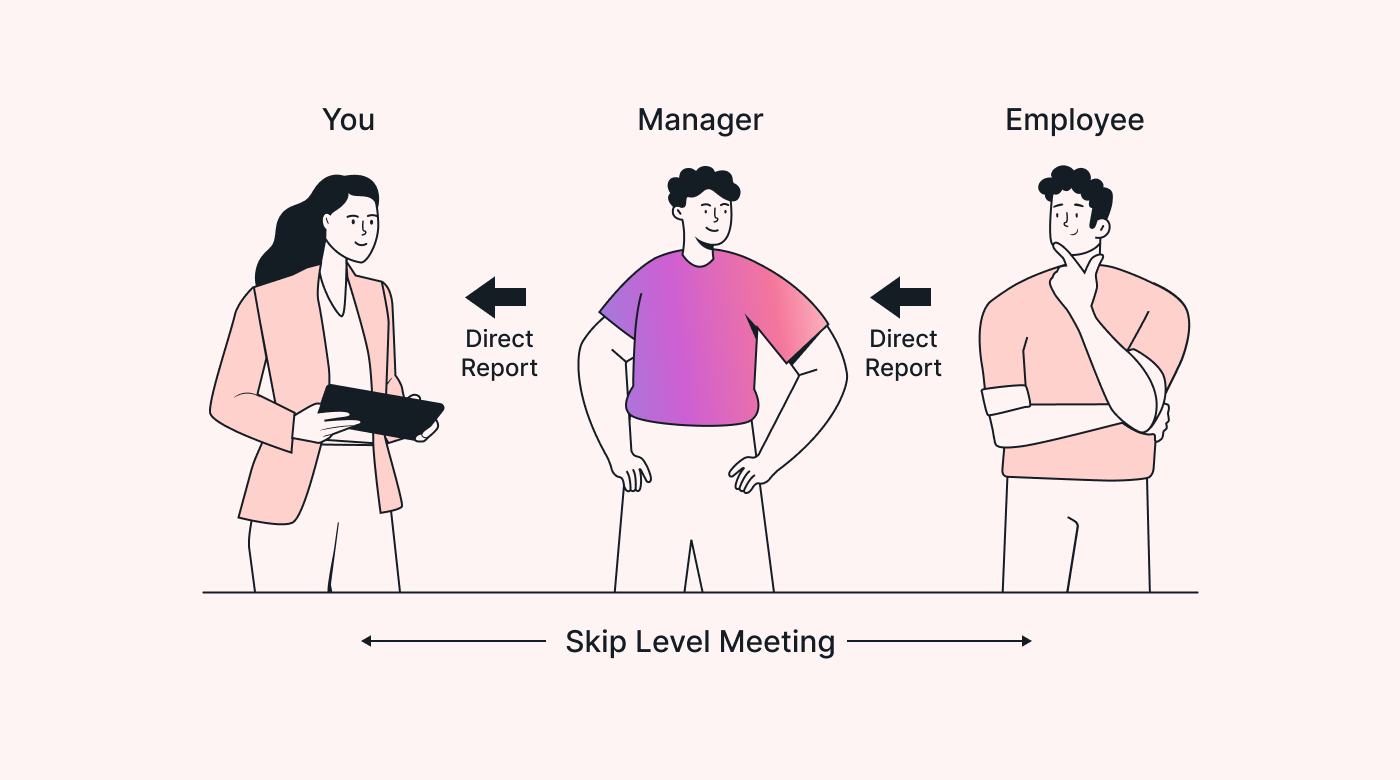Traditional companies are hierarchical, and generally speaking, the bigger the company, the more levels there are in the hierarchy. People at the top rarely encounter people at the bottom for longer than it takes to say “hi” in the hallway. And that’s a problem.
It’s a problem because it means the executive suite is disconnected from those who work to keep the company going. Senior management must rely on middle management to know what’s happening in the engine room. And middle management are people, too. They also have blind spots, poor perceptions, and biases.
Skip-level meetings are a way around this. They open a dialogue between senior management and lower-level employees. The way it works is for employees to meet with their manager’s manager. It’s a powerful tool that offers valuable insights, improves transparency, and builds stronger connections.
But there could be unintended consequences, so you must handle them with care.
It’s a high-stakes game
You must tread carefully if you’re instituting them for the first time. The problem is that people are naturally suspicious of other people’s motives. So, when a manager hears that their boss wants to meet with one of their direct reports, it could create tension. And that tension will ratchet up if more than one layer of management is being skipped over.
It can also be rather stressful for an employee invited to the skip-level meeting. They’ll be full of questions themselves, often including: “Did I do something wrong?” Or “Am I being fired?”
Because skip-level meetings can prompt such insecurities, you should plan them in some detail. Devise an agenda, objectives, and questions, and encourage participants to bring their own questions.
Benefits of skip-level meetings
Despite the risks, there are real benefits to be had from skip-level meetings. The greatest of these is the ability to build a rapport between people at all levels of your business. This will also help you to make sure:
- Employees are aligned on your company’s goals
- All team members get to interact with senior leaders
- Better relationships are fostered at all levels
- Transparency is promoted, and damaging gossip is avoided
- Decision-making is improved across the business.
But there’s more. Skip-level meetings allow upper-level managers to step into a mentoring role, helping others navigate roadblocks or career interests. They can also improve engagement and help build a harmonious and empowering work environment.
Anatomy of a skip-level meeting
Skip-level meetings are regular but infrequent appointments between people in the same business, but from different levels. It works better as a one-on-one meeting, so it's usually only two people, but it can be more.
 |
Purpose of skip-level meetings
Although the senior manager usually prompts these meetings, it’s not a one-way street. There are benefits in them for both parties. As a senior leader, you can build trust and gain new perspectives. It also gives you access to unfiltered information about what happens on the factory floor, or in the field.
As an employee, it’s not every day that you get to pick the brains of a senior manager, someone who knows where the company is headed. It’s a fantastic opportunity to float the ideas you’ve had to improve systems or products while toiling at your workstation. It’s also a chance to make a good impression or to build on the relationship established in previous skip-level meetings.
Who should do them and why?
Every organization has a hierarchy, whether it’s a formal one or not. And your perception of the business will likely be governed by your perceived place in that hierarchy. And this is the logic behind skip-level meetings.
Putting two people with different perspectives in a room benefits both of them. It can also help the business. Besides the unfiltered feedback, skip-level meetings can help bridge disconnects and encourage teamwork and camaraderie. They can also spark brand-new ideas.
How often and how long?
The general rule of thumb is at least twice yearly, with every employee below a certain level. HR specialists suggest an hour per meeting but also report that 30 minutes can work if you plan well and stay focused.
If that sounds like a lot, let’s do the math. In a hypothetical business or department with 100 employees, about 20% will probably be at some management level. That leaves about 80 people you or other senior managers must meet with.
An average of 20 working days per month means you can do a one-hour daily meeting over a four-month cycle. That gives you two months between cycles.
Or you could set aside every Friday afternoon and do four 30-minute skip-level meetings a week over five months, with a month’s break between cycles. The possible combinations are endless, but that doesn’t affect your preparation time.
How to prepare
This isn’t just one person’s meeting. If it’s going to deliver value, both participants must be well-prepared for the meeting. At the same time, the more junior participants may need some guidance or pointers to prepare properly.
As an employee
If you’re the employee going into a skip-level meeting, you’ll be at least a little nervous — especially if it’s your first one. But you should remember that your manager wants this meeting because they think you might have some valuable insight into the business for them.
Managers understand that people on the frontline of a business often have ideas to improve processes and systems if only somebody asks them. And that’s what this is about. But if you don’t have any ideas now, that’s OK. You will at some point, and then you’ll have the relationship and the opportunity to present them.
You might even have questions about the industry, the business, and competitors. Now’s your chance to ask them, so have them prepared. But if you haven’t yet, that’s also OK.
For now, you just need to work on and develop that relationship. That means learning a little about your manager. Google is a wonderful tool that may provide insight. So are LinkedIn and other social media sites where they have a presence. You never know; you may have something in common!
As a manager
The first thing to consider is the location of the meeting. A neutral venue is always best because everyone is at ease from the start. But that’s not always practical and may add costs because of travel time and expense.
 |
Also, and purely from a logistics point of view, it’s probably better for the meeting to take place in your office or a private boardroom. It’s important that you remember that, for your employees, that can feel like being called to the principal’s office.
And if it's a first meeting, you should also take the trouble to know a little about the person you're meeting before you sit down. Have a look through their personnel file to familiarize yourself with them, their education, and their background.
Look for ways in which you can relate to them. Where did they grow up? What schools did they go to? Where did they work before joining your company? Are any hobbies or interests listed in their resume?
All of that may sound wrong because the goal of your meeting is business-related. But, if you’re going to build trust and get valuable insight from the meeting, you have to connect with your employees on a personal level, even if it’s just for an hour.
Cue cards or a notebook are handy tools for you to use as prompts during the meeting. You should prepare something like that, but using actual physical cue cards in the meeting is probably not wise.
How to run a skip-level meeting
As the senior person in the room, you must run the meeting. Many different variables will determine your exact skip-level meeting agenda, but the basic structure should be pretty standard.
- Welcome. It’s important to get off on the right foot, and a senior manager offering a drink (coffee, water, juice, etc.) and personally handing it over sets the right tone. Cookies or donuts would be a nice touch (or something with fewer carbs, perhaps).
- Introduction (if it’s a first meeting). It’s important to set an informal tone. You’re just two colleagues meeting for a coffee and pastry. Provide some information about yourself that’s not in official company literature. Try to be modest. Ask your employee to tell you a little about themselves.
- Connection. Now’s the time to use anything you learned about the person that connects you: a shared interest, a common school, a similar background or upbringing, a mutual friend, anything. If you have nothing like that, there’s the business you both work in. Use that commonality to build a personal connection.
- The business of the meeting. You’ll have prepared questions to ask during your research for this meeting. Now’s the time to run through them and any others prompted by your employee’s answers.
- Invite comments and their questions. This is where you reciprocate by being as open and honest as possible. You may be asked something about another employee or the business that you shouldn’t answer. In that case, be upfront about it. Acknowledge the question and explain why you can’t or shouldn’t answer it. Always remember that building trust is a big part of this whole exercise.
- The close. Thank them for their time, share your next steps, and restate how you’ll use the information. Time to get back to work. See you again in three, four, five, and six months. If you need to talk before, my door is always open. Just pop me an email or a private message to give me an idea of why you want to meet.
Skip-level meeting questions to ask
As a manager
- What is some good news that you'd like to share?
- What do you think of the business?
- What are we doing right?
- What do you think we’re getting wrong?
- What do you believe are our most significant challenges as a business?
- How can I be better at supporting our team and the larger organization?
- What trends or changes have you noticed in the market that we should be considering?
- What projects at work have you most enjoyed working on?
- What is your favorite thing to do outside of work?
- If there was one thing that you could "fix" in the company, what would it be?
- What would you change if you were in my position?
- How could we make better use of your unique skills?
- Would you recommend working here to your friends?
- Why?
- Why not?
- What are your career goals for the next few years?
- How can we help you achieve those goals?
- What is your favorite book, podcast, or movie?
- Among your coworkers, who impresses you most and why?
- Does everyone on your team have the skills to fill their role effectively?
- Or do some people need more training or development opportunities?
- Is there anything else that we should discuss?
As an employee
- Where is the business going?
- What are my prospects for growth?
- Are there any mentorship opportunities available for me?
- What skills do you think we’re lacking on our team?
- How can I help train and support others in the company?
- Who in the company do you think I can learn the most from?
- How are we progressing on our goals as a company?
- What big changes do you see coming in the next six months?
- What’s something you wish we did better as a team?
- What are we doing for our products/services to stand out in the market?
- What’s worrying senior leadership right now?
- How can I get more involved in workplace culture?
- Are there any aspects of our culture you wish you could change?
- What’s worrying you most?
- What’s your biggest challenge as a leader?
- What would it look like for you if our team knocked it out of the park?
What skip-level meetings aren’t
There are some things that skip-level meetings shouldn’t be used for:
- They are NOT about checking on the performance of a direct manager by “going around them.”
- They are NOT to manage priorities or career management or perform any duties typically handled by a team member’s direct manager.
Using technology to maximize time
There’s no getting away from it; skip-level meetings can be a chore. The biggest problem is admin. Certainly, you can shift the research onto someone else. But your meeting will get awkward if your employee notices you’re reading notes you didn’t take.
It’ll also defeat building trust and rapport with your employees. It may look like you’re just going through the motions for them.
The other admin issue is scheduling. Fortunately, Motion can help with its AI-powered calendar app, which doubles as a task management tool, a meeting scheduler and a project manager app. Once you set your priorities, it can automatically schedule your skip-level meetings and a research task for a day and time that suits you and your employees.
Sign up for our free 7-day trial to see how it can transform how you manage your time and your business.







